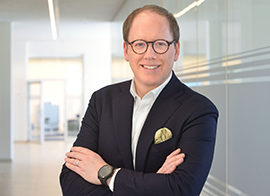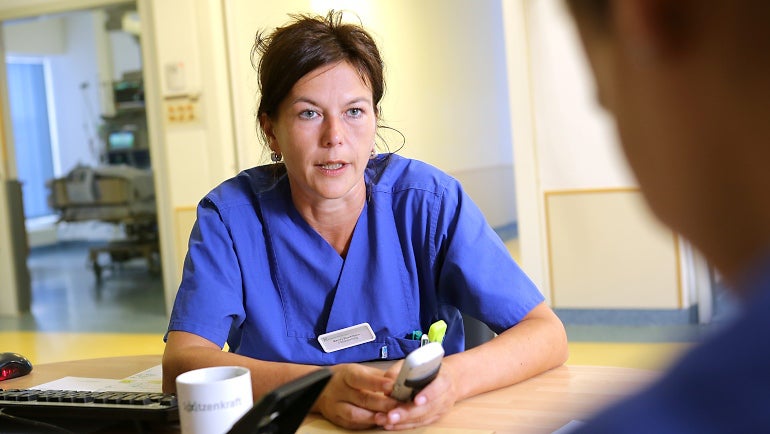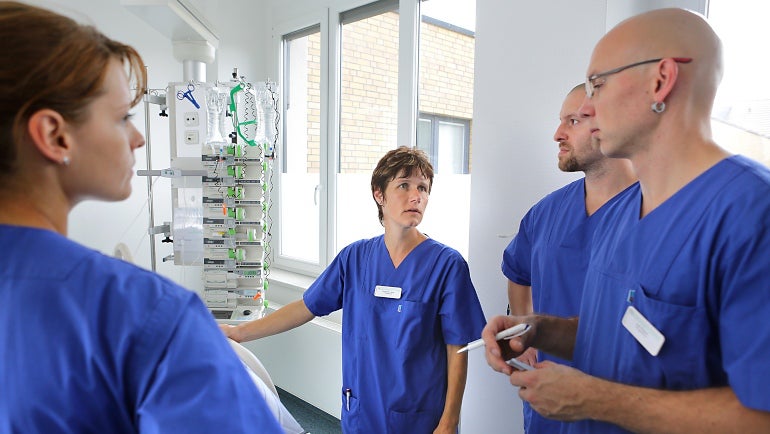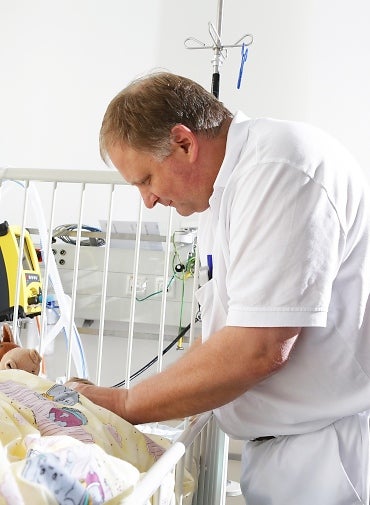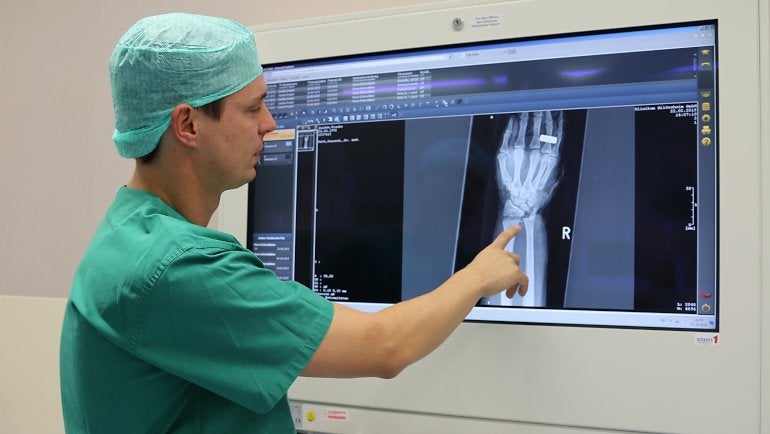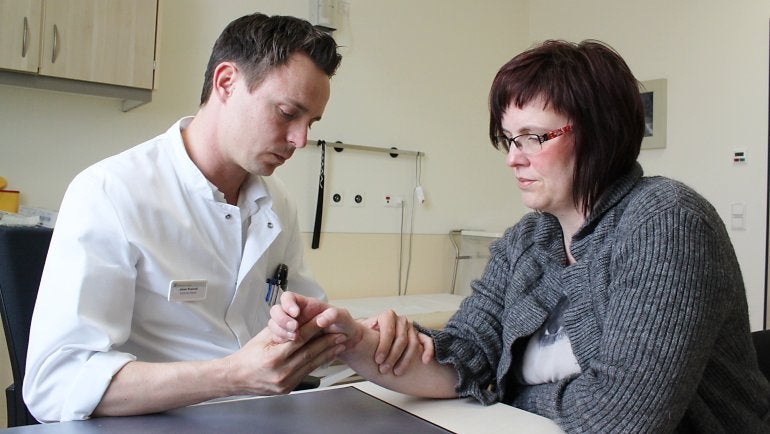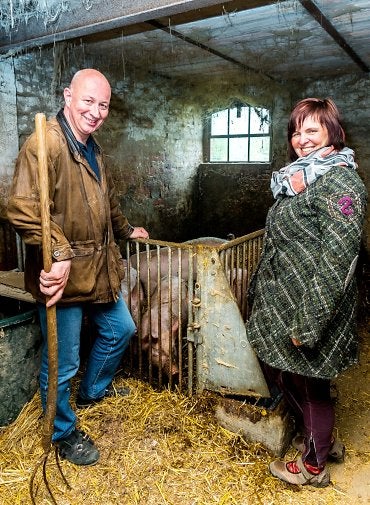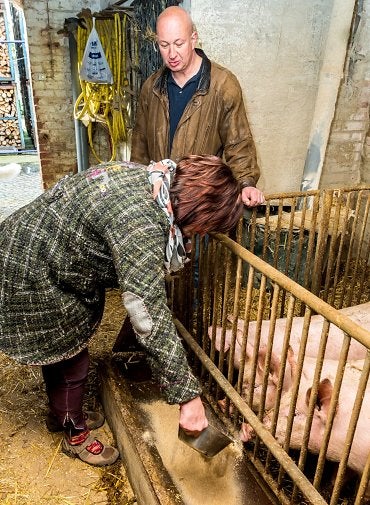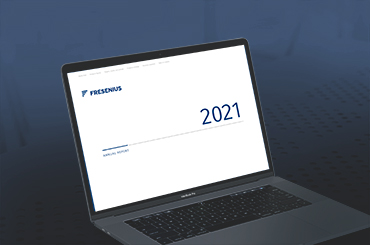
March 24, 2022
Bad Homburg, Germany
Annual Report 2021
Consolidated Financial Statements and Management Report (IFRS)
There’s not much conversation in the locker room at 6:30 a.m., as the six women change into the blue uniforms worn on the Intensive Care Unit. The handover from their overnight colleagues proceeds quietly — it was an uneventful night. But the day ahead? On the ICU, it’s impossible to know.
(Published: March 2015)
ICU head nurse Mandy Stockmann is busy handing out assignments. “When possible, we team up the less experienced people with the veterans,” she says. By any standard, Stockmann is a veteran: she has been heading the 67-member ICU nursing team at Fresenius Helios Hospital Bad Saarow, just east of Berlin, since she was 26.
Each member of the Bad Saarow ICU team is trained to deal with the life-threatening emergencies that can strike the ICU’s critically ill patients at any time. Many have just had major surgery or have advanced pneumonia. Others have suffered a serious heart attack or stroke, or devastating brain or internal injuries.
“We treat every patient like they were our own mother or father.”
Stockmann turns to hurry “downtown” — the English name the nurses have given the busy central corridor running between the ICU unit’s two wings, with their total of 36 beds. Downtown is where the doctors and nurses gather for their “morning rounds” to see the patients. The beeping of sophisticated medical equipment deployed throughout the ICU, along with the hoses, cables and flashing monitors — it can all seem daunting. For the ICU patients surrounded by — and often attached to — these life-saving machines, it is crucial that they sense the staff’s compassion, and special attention is given to treating them as gently and kindly as possible. “We treat every patient like they were our own mother or father,” says the head of the ICU, Dr. Uli-Ruediger Jahn.
“How was your night? Do you have any pain?” Jahn quietly asks a patient. During the morning visit he is highly focused, and expects the same from the staff. “This is the most important time of the day,” Jahn explains. “It’s the only time that the different specialist doctors all come together as a multi-disciplinary team. Everyone really has to listen closely.”
12:30 p.m.: Just after noon, the colleagues gather in Jahn’s office. Their faces etched in concentration, they examine the X-rays of patients as colleagues outside continue to closely monitor patients. The frequent checking of vital signs and medication levels, the carrying out of specially ordered tests such as lung endoscopies, as well as respiration therapy and the various measures needed to support patients’ circulatory systems: these are among the regular duties in the ICU workday.
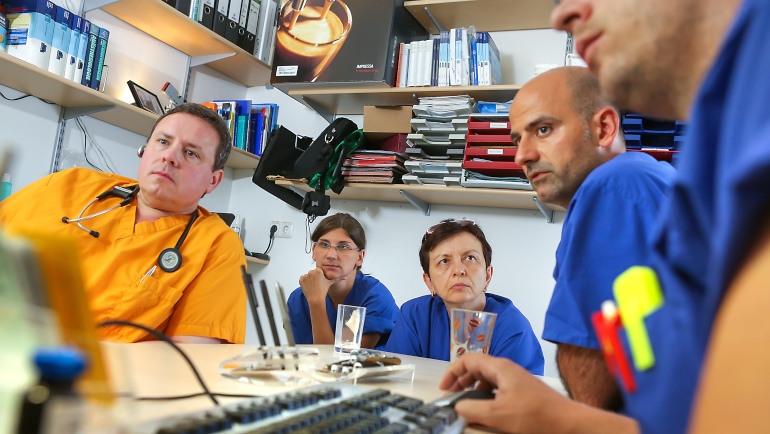
“Interdisciplinary cooperation takes on a different level of significance in the ICU,” and the nursing staff is on the front line of care, says Dr. Stefan Wirtz, the hospital’s Chief Physician for Anesthesiology, Intensive Care Medicine, Emergency Care Medicine and Pain Therapy. After all, he points out, it is the nurses who spend the most time with the patients, watch over them day and night, and notice even the smallest changes in their condition. “You can only do medicine well when you work in friendly cooperation with your colleagues,” Wirtz adds. “That’s true for doctors and for the nursing staff.
5 p.m.: Another long day ends for Mandy Stockmann at 5 p.m., and she turns to the important business of properly winding down. “Symbolically, it’s important to leave all your private worries in your locker when you start your shift, and then put work problems or your concerns about the patients aside, along with your uniform, at the end of your day,” Stockmann explains. “And I really long for peace and quiet, so I turn the phone off for an hour when I get home.”

The night shift takes over at 10 p.m., with nurse Uwe Bogner as shift leader. This night soon sees him racing over to a nearby station to assist colleagues in helping a very heavy patient back into bed. Then word comes in that a planned emergency operation is being canceled because the patient is too weak, and all the equipment that the staff had brought out and set up for post-surgical care must now be put away. Other nurses, meanwhile, organize things for the day shift, while the physician on call attends to a patient who cannot come to rest; everyone knows that fear and anxiety do most of their visiting at night. The night shift is drawing to a close in the Bad Saarow ICU when Uwe Bogner approaches a patient to clear his throat of fluid that could obstruct breathing. The nurse knows the sedated patient will not be able to answer, but he takes a moment to speak to him all the same. “Good evening, Mr. K,” Bogner says softly. “Hope I didn’t startle you.”
6:30 a.m.: The unit is quiet. Three doors down, Uwe Bogner’s colleagues have arrived for the early shift and are quietly changing into their blue ICU uniforms.
Dr. Uli-Ruediger Jahn has assumed the position of Chief Physician for Anesthesiology, Intensive and Emergency Medicine and Pain Therapy at HELIOS Hospital Uelzen, in northern Germany. The Intensive Care Unit and the clinic for Anesthesiology and Pain Therapy have since become separate specialist departments within HELIOS Hospital Bad Saarow. Dr. Stefan Wirtz is Chief Physician, and Ali Allam is Senior Consultant, in the Intensive Care Unit.
Contact
Helios Kliniken GmbH
Friedrichstr. 136
10117 Berlin
Germany
T +49 30 521 321-0
December 08, 2021
Bad Homburg, Germany
Credit Suisse – 10th Annual December Bus Tour
Usage of Alternative Performance Measures
The Fresenius Group uses alternative performance measures in its regulatory and mandatory publications that may represent so called non-GAAP-measures. These indicators are neither defined by US-GAAP nor by IFRS.
Within the internal control system of Fresenius non-GAAP-measures are used as key performance indicators.
The use of non-GAAP-measures for evaluating assets, financial and earnings position of Fresenius is not recommended on an isolated basis or as an alternative to the key performance indicators provided within the consolidated financial statements prepared in accordance with US-GAAP and IFRS.
The non-GAAP-measures used are listed and explained below:
In order to measure the operating performance extending over several periods, key performance measures are “adjusted“ where applicable.
Adjustments may arise from acquisitions/divestitures or the adoption of new accounting standards. Reconciliation tables are available within the respective quarterly or annual report and present the composition of adjustments.
EBIT does include depreciation and write-ups on property, plant and equipment.
EBIT is calculated by subtracting cost of sales, selling, general and administrative expenses and research and development expenses from sales.
EBIT margin is calculated as the ratio of EBIT to sales.
EBITDA is calculated from EBIT by adding depreciations recognized in income and deducting write-ups recognized in income, both, on intangible assets as well as property, plant and equipment.
EBITDA margin is calculated as the ratio of EBITDA to sales.
Financial key figure that shows the net balance of incoming and outgoing payments during a reporting period.
Operating cash flow is a financial measure showing cash inflows from operating activities during a period. Operating cash flow is calculated by subtracting non-cash income and adding non-cash expenses to net income.
Cash flow from investing activities is a financial measure opposing payments for the acquisition or purchase of property, plant and equipment and investments versus proceeds from the sale of property, plant and equipment and investments.
Cash flow from financing activities is a financial measure showing how the investments of the reporting period were financed.
Cash flow from financing activities is calculated from additions to equity plus proceeds from the exercise of stock options less dividends paid plus proceeds from debt increase (loans, bonds, senior notes, etc.) less repayments of debt plus the change in noncontrolling interest plus proceeds from the hedge of exchange rate effects due to corporate financing.
Fresenius uses the cash flow before acquisitions and dividends as the financial measure for free cash flow. Cash flow before acquisitions and dividends is calculated by operating cash flow less investments (net). Net investments are calculated by payments for the purchase of property, plant and equipment less proceeds from the sale of property, plant and equipment.
The cash conversion rate is defined as the ratio of adjusted free cash flow (cash flow before acquisitions and dividends; before interest, tax and special items) to operating income (EBIT) before special items. This allows us to assess our ability to generate cash and amongst others, also to pay dividends.
Net debt/EBITDA is a financial measure reflecting the ability of Fresenius to fulfill its payment obligations. Net debt and EBITDA are calculated at LTM (last twelve month) average exchange rates respectively.
Calculation of net debt:
Short-term debt
+ Short-term debt from related parties
+ Current portion of long-term debt and capital lease obligations
+ Current portion of Senior Notes
+ Long-term debt and capital lease obligations, less current portion
+ Senior Notes, less current portion
+ Convertible bonds
= Debt
- less cash and cash equivalents
= Net debt
Indicates the average number of days it takes for a receivable to be paid.
Growth that is generated by a company’s existing businesses and not by acquisitions, divestitures, or foreign exchange impact.
Constant currencies for income and expenses are calculated using prior year average rates; constant currencies for assets and liabilities are calculated using the mid-closing rate on the date of the respective statement of financial position.
Measure of a corporation’s profitability revealing how much profit a company generates
with the money shareholders have invested. ROE is calculated by fiscal year’s net income / total equity x 100.
Calculated by: (EBIT - taxes) / Invested capital
Invested capital = total assets + amortization of goodwill (accumulated) - deferred tax assets - cash and cash equivalents - trade accounts payable - accruals (without pension accruals) - other liabilities not bearing interest
Reconciliation of average invested capital and ROIC
| € in millions, except for ROIC | 31.12.2021 | 31.12.2020 |
|---|---|---|
Total assets | 71,962 | 66,646 |
Plus: Cumulative goodwill amortization | 719 | 690 |
Minus: Cash and cash equivalents | - 2,764 | - 1,837 |
Minus: Loans to related parties | - 63 | - 62 |
Minus: Deferred tax assets | -858 | -812 |
Minus: Accounts payable | - 2,039 | - 1,816 |
Minus: Accounts payable to related parties | - 92 | - 67 |
Minus: Provisions and other current liabilities1 | - 8,925 | - 8,649 |
Minus: Income tax payable | - 495 | - 504 |
Invested Capital | 57,445 | 53,589 |
Average invested capital as of December 31, 2021 / 20202 | 55,893 | 54,648 |
Operating income3,4 | 4,260 | 4,614 |
Income tax expense | - 964 | - 1,065 |
NOPAT3,4 | 3,296 | 3,549 |
ROIC in % | 5.9 % | 6.5 % |
-
1 Includes non-current provisions and payments outstanding for acquisition; does not include pension liabilities and noncontrolling interest subject to put provisions.
2 Includes adjustments for acquisitions in the respective reporting period with a purchase price above a certain level
(2021: € 752 million; 2020: € 220 million).
3 Includes adjustments for acquisitions in the respective reporting period with a purchase price above a certain level
(2021: € 8 million; 2020: € 2 million).
4 Before special items
Calculated as the ratio of EBIT to operating assets (average).
Operating assets = total assets - deferred tax assets - trade accounts payable - cash held in trust - payments received on account - approved subsidies
Reconciliation of average operating assets and ROOA
| € in millions, except for ROOA | 31.12.2021 | 31.12.2020 |
|---|---|---|
Total assets | 71,962 | 66,646 |
Minus: Contract liabilities | - 535 | - 962 |
Minus: Payments received on account | 0 | 0 |
Minus: Cash held in trust | - 154 | - 121 |
Minus: Loans to related parties | - 63 | - 62 |
Minus: Deferred tax assets | - 858 | - 812 |
Minus: Accounts payable | - 2,039 | - 1,816 |
Minus: Accounts payable to related parties | - 92 | - 67 |
Minus: Approved subsidies due to Hospital Funding Act („Krankenhausfinanzierungsgesetz“, KHG) | - 118 | - 82 |
Operating assets | 68,103 | 62,724 |
Average operating assets as of December 31, 2021 / 20201 | 65,384 | 62,976 |
Operating income2,3 | 4,260 | 4,614 |
ROOA in % | 6.5 % | 7.3 % |
-
1 Includes adjustments for acquisitions in the respective reporting period with a purchase price above a certain level
(2021: € 868 million; 2020: € 346 million).
2 Includes adjustments for acquisitions in the respective reporting period with a purchase price above a certain level
(2021: € 8 million; 2020: € 2 million).
3 Before special items
Indicates the average number of days between receiving goods as inventory and the sale of the finished product.
Calculated by: (Inventories / Costs of goods sold) x 365 days
In order to measure the operating performance extending over several periods, key performance measures are adjusted by special items, where applicable. Adjusted measures are labelled with “before special items”. A reconciliation table is available within the respective quarterly or annual report and presents the composition of special items.
Current assets (including deferred assets) - accruals - trade accounts payable - other liabilities - deferred charges
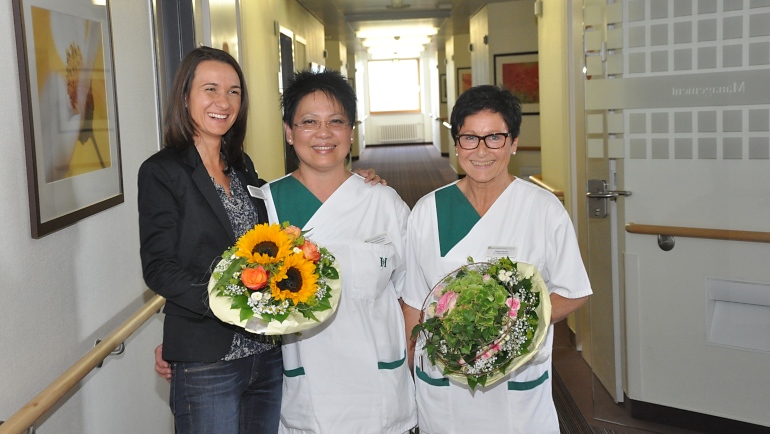
Her first look at Germany on that long-ago morning was not very encouraging. “Everything here looks so gray and dismal,” Florence de Peralta remembers thinking as she landed in Frankfurt back in February 1972. The young nurse was used to the warm temperatures of her native Philippines, not the cold winters of western Europe. But she had taken a decision to pursue a new life, so she got off the plane and started building it.
(Published: August 2015)
Forty-four years later, de Peralta, now 67 and recently retired from HELIOS Hospital Hünfeld, can look back on a successful career at the hospital and the founding and raising of a family in Germany. She’s glad she came, and that she stayed, even if it wasn’t always easy.
When Florence de Peralta arrived along with five other young Philippine nurses assigned to the hospital in Hünfeld, a town of 16,000 people some 100 kilometers (60 miles) north of Frankfurt, Germany was far less multicultural than it is today. The six nurses only came because of an intergovernmental agreement that nurses from the Philippines would work in Germany to help overcome a serious nursing shortage. In total, some 3,000 Philippine nurses came between 1969 and 1973. Thousands of nurses from India and Korea were also recruited during those years.
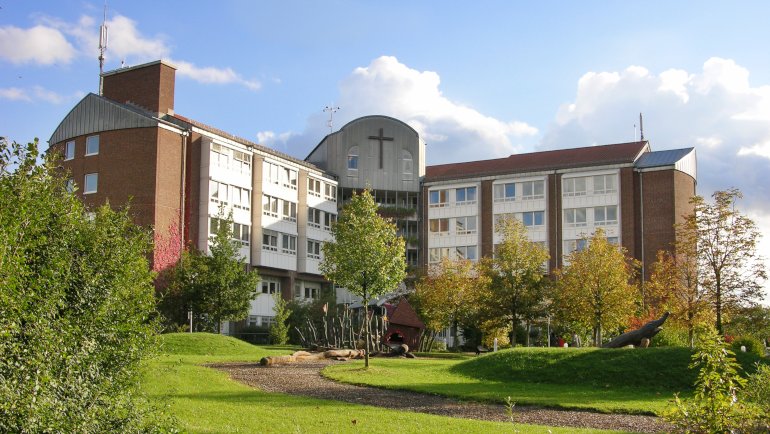
Today, advance preparation – especially language training – is customary for newcomers to Germany, but in Florence de Peralta’s day it wasn’t thought necessary. She arrived not knowing a word of German but was still expected to start right away at the hospital, “where we communicated with hand signals,” and take language lessons later.
She soon got used to her new country, though, with the help of colleagues and many friendly local people, including some families who helped her settle in and find her way around. “I was given a very warm welcome everywhere, both from the people in Hünfeld and from the colleagues and patients in the hospital,” Florence de Peralta recalls.
Still, Hünfeld is a small town, de Peralta was away from family and friends and living in a country with a very different culture. At times, homesickness was hard to shake. Then, at a gathering of the German-Philippine Association in Mainz, just west of Frankfurt, she bumped into Arsenio, whom she had known before taking her training back home. “He wouldn’t let me go,” she jokes of the man who would become her husband and with whom she has two children, Florian and Jennifer. She and Arsenio even worked together for a time in the Hünfeld hospital.
Florence de Peralta enters retirement with mixed feelings – sorry to say goodbye to work that has given her so much satisfaction, but grateful for the memories, the friends and colleagues, not to mention the many happy years of family life. “Nursing has brought me a lot of pleasure and joy,” Florence de Peralta says. “Having some understanding and sympathy for ill people and looking after them – that has always been my passion.” And for Florence and Arsenio de Peralta, there is still a lot to look forward to – including a long trip back to the country they left behind all those years ago for their new home in Germany.
Without the successful surgery by the medical team at HELIOS Hospital Hildesheim, life might have taken a hard turn for Frauke Quidde. She was cutting firewood on her small farm last year when her hand slipped inside a log-splitting machine and was almost completely severed at the wrist. “It was a total, absolute shock,” she recalled. “My right hand was literally hanging by threads.”
(Published: January 2016)
Every minute counted now. While waiting for emergency personnel to arrive at the farm near Braunschweig – a northern German city also known as Brunswick – Frauke Quidde had to use her left hand to hold the severed hand in place as best she could. Then she was moved into a rescue helicopter, which flew her approximately 45 kilometers (28 miles) to HELIOS Hospital Hildesheim, where a surgical team headed by Dr. Bernd Rieck was standing ready in the operating room.
“It was crucial to restore the blood flow as quickly as possible,” explained Dr. Rieck, Chief Physician in the hospital’s Plastic, Aesthetic and Hand Surgery Department. “Every quarter hour increases the risk of permanent damage to the hand. So we not only needed to work very precisely, but also very quickly.”
“I was very lucky, but for me it was really a medical masterpiece.”
Dr. Rieck, Resident Physician Jakob Krainski and the rest of the team decided to rejoin the blood vessels, tendons and nerves before stabilizing the bone – a reversal of the usual order. By the time blood started recirculating through the hand, “only” three hours had elapsed. “That is a phenomenally good time,” Dr. Rieck explained. “You had an old veteran like me and a young master working together at the operating table. This operation had already been performed at other hospitals, but they didn’t all do it as well. It was real teamwork.”
Just two days after the accident, Frauke Quidde could start moving her fingers, and she continued to make rapid progress during rehabilitation. Today, she is back working on the farm, doing all the things she did before: harvesting fruit, driving the tractor, and feeding the animals.

“Ms. Quidde is an extraordinarily brave and determined woman,” said Jakob Krainski. “The excellent result is also attributable to her positive approach: She really supported all the therapies and gave tremendous cooperation. I’m really proud of my patient, and she should feel proud, too.”
What Frauke Quidde mostly feels, though, are a sense of gratitude and a deep appreciation that she has been able to return to her old, active life. “I’m really thankful to the doctors, the nurses and the rest of the staff in Hildesheim that I can move my hand again and drive a car, and above all that I can lead an independent life,” she said. “That’s why it was clear to me that the first card I could write from the rehabilitation clinic would be to the medical team in Hildesheim. It was just a small ‘thank you’ to the doctors and the medical staff in the hospital. I was very lucky, but for me it was really a medical masterpiece. My husband and I are unbelievably grateful.”
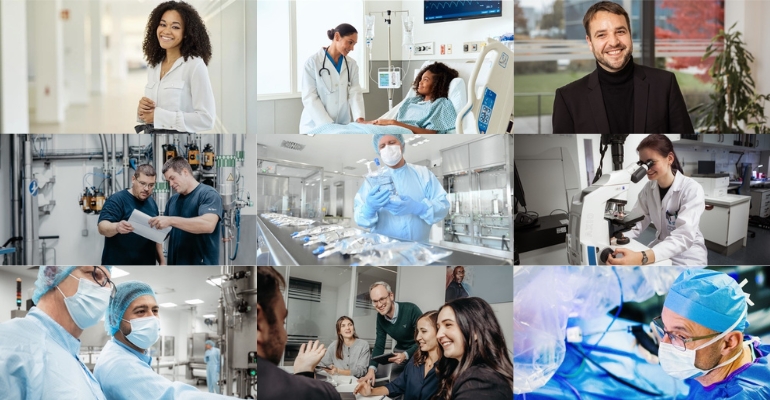
Fresenius is a global healthcare company headquartered in Bad Homburg v. d. Höhe, Germany. In fiscal year 2024, Fresenius generated €21.5 billion in annual revenue with over 176,000 employees (excluding Fresenius Medical Care). As a healthcare company focused on therapy, Fresenius offers system-critical products and services for leading therapies for the care of critically and chronically ill patients.
The Fresenius Group comprises the Operating Companies Fresenius Kabi and Fresenius Helios as well as the Investment Company Fresenius Medical Care.

